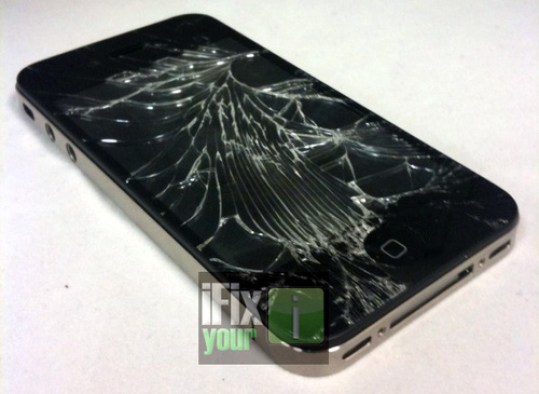
The screen for Apple’s upcoming iPhone 4 may not be as big an improvement as Apple wants us to believe, according to the folks over at iFixyouri. The repair firm recently received its first iPhone 4 replacement parts and decided to see if the device’s screen lived up to Apple’s marketing hype. After three drops from 3.5 feet, their experiment was answered with a loud pop, and a shattered glass screen.
[aditude-amp id="flyingcarpet" targeting='{"env":"staging","page_type":"article","post_id":190191,"post_type":"story","post_chan":"none","tags":null,"ai":false,"category":"none","all_categories":"business,mobile,","session":"B"}']Apple describes the aluminosilicate glass used in the iPhone 4’s screen and back as “the same type of glass used in the windshields of helicopters and high-speed trains.” It’s also strengthened to be “20 times stiffer and 30 times harder than plastic.” In short, it’s supposed to be a huge improvement over previous iPhone screens — which tended to crack easily when dropped and were prone to scratches.
It’s important to note that iFixyouri dropped the device without internal components, which in a final unit may help to distribute the impact of a fall. We won’t know for sure how durable the screen really is until the iPhone 4 is out in reviewer hands, and someone is crazy enough to stress test it.
AI Weekly
The must-read newsletter for AI and Big Data industry written by Khari Johnson, Kyle Wiggers, and Seth Colaner.
Included with VentureBeat Insider and VentureBeat VIP memberships.
The website Machine Design (via the Glass Quarterly blog) offers a more technical description of the glass:
Aluminosilicate glass (in which some alumina, Al²O³, replaces silica) is another thermal-shock-resisting glass similar to borosilicate but able to withstand higher operating temperatures. These glasses also resist chemical attack and are good electrical insulators. Aluminosilicate glasses are suited for high-performance applications such as high-temperature thermometers, space-vehicle windows, and ignition tubes. Coated with an electrically conductive film, they are used as resistors in critical electronic circuitry. Aluminosilicates cost about three times more than borosilicates and are appreciably more difficult to fabricate.
Clearly, the glass should be more than strong enough to withstand a 3.5 foot drop. Competing Android phones like the Motorola Droid are using Gorilla Glass technology to protect from scratches and other damage. Apple needs to make sure that it’s at least maintaining the same level of durability of those devices. Durability is even more important now that the iPhone 4 will have glass on its back, instead of the plastic used on the iPhone 3G and 3G S.
Until we know for sure how durable the screen is, Apple’s upcoming Bumper iPhone cases will help you keep some piece of mind. But of course, that’s exactly what they want you to think.
[Image via iFixyouri]
VentureBeat's mission is to be a digital town square for technical decision-makers to gain knowledge about transformative enterprise technology and transact. Learn More
